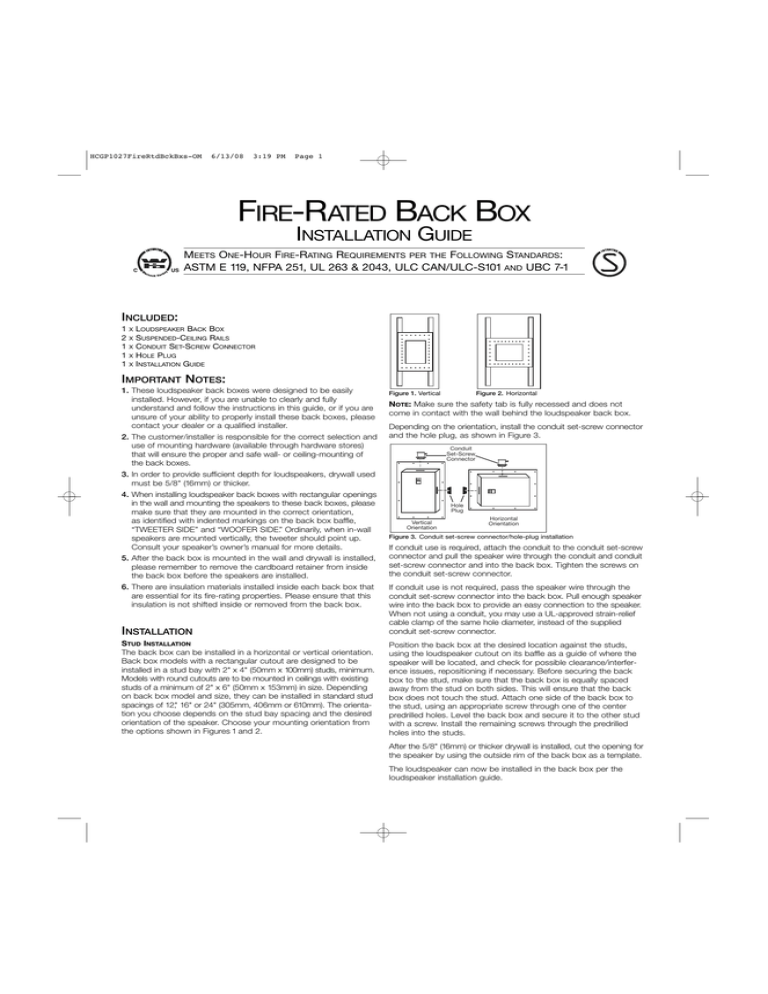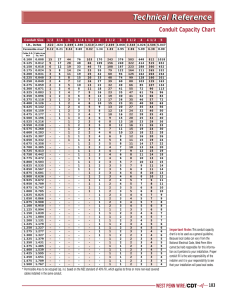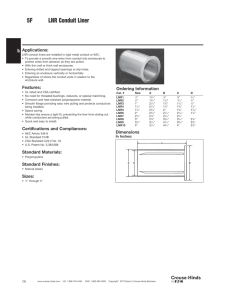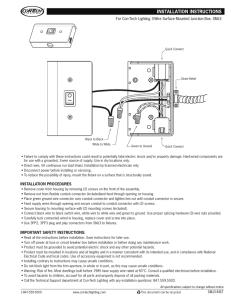
HCGP1027FireRtdBckBxs-OM
6/13/08
3:19 PM
Page 1
FIRE-RATED BACK BOX
INSTALLATION GUIDE
MEETS ONE-HOUR FIRE-RATING REQUIREMENTS PER THE FOLLOWING STANDARDS:
ASTM E 119, NFPA 251, UL 263 & 2043, ULC CAN/ULC-S101 AND UBC 7-1
INCLUDED:
1
2
1
1
1
X
X
X
X
X
LOUDSPEAKER BACK BOX
SUSPENDED-CEILING RAILS
CONDUIT SET-SCREW CONNECTOR
HOLE PLUG
INSTALLATION GUIDE
IMPORTANT NOTES:
1. These loudspeaker back boxes were designed to be easily
installed. However, if you are unable to clearly and fully
understand and follow the instructions in this guide, or if you are
unsure of your ability to properly install these back boxes, please
contact your dealer or a qualified installer.
2. The customer/installer is responsible for the correct selection and
use of mounting hardware (available through hardware stores)
that will ensure the proper and safe wall- or ceiling-mounting of
the back boxes.
Figure 1. Vertical
Figure 2. Horizontal
NOTE: Make sure the safety tab is fully recessed and does not
come in contact with the wall behind the loudspeaker back box.
Depending on the orientation, install the conduit set-screw connector
and the hole plug, as shown in Figure 3.
Conduit
Set-Screw
Connector
3. In order to provide sufficient depth for loudspeakers, drywall used
must be 5/8" (16mm) or thicker.
4. When installing loudspeaker back boxes with rectangular openings
in the wall and mounting the speakers to these back boxes, please
make sure that they are mounted in the correct orientation,
as identified with indented markings on the back box baffle,
“TWEETER SIDE” and “WOOFER SIDE.” Ordinarily, when in-wall
speakers are mounted vertically, the tweeter should point up.
Consult your speaker’s owner’s manual for more details.
5. After the back box is mounted in the wall and drywall is installed,
please remember to remove the cardboard retainer from inside
the back box before the speakers are installed.
6. There are insulation materials installed inside each back box that
are essential for its fire-rating properties. Please ensure that this
insulation is not shifted inside or removed from the back box.
Hole
Plug
Vertical
Orientation
Horizontal
Orientation
Figure 3. Conduit set-screw connector/hole-plug installation
lf conduit use is required, attach the conduit to the conduit set-screw
connector and pull the speaker wire through the conduit and conduit
set-screw connector and into the back box. Tighten the screws on
the conduit set-screw connector.
INSTALLATION
lf conduit use is not required, pass the speaker wire through the
conduit set-screw connector into the back box. Pull enough speaker
wire into the back box to provide an easy connection to the speaker.
When not using a conduit, you may use a UL-approved strain-relief
cable clamp of the same hole diameter, instead of the supplied
conduit set-screw connector.
STUD INSTALLATION
The back box can be installed in a horizontal or vertical orientation.
Back box models with a rectangular cutout are designed to be
installed in a stud bay with 2" x 4" (50mm x 100mm) studs, minimum.
Models with round cutouts are to be mounted in ceilings with existing
studs of a minimum of 2" x 6" (50mm x 153mm) in size. Depending
on back box model and size, they can be installed in standard stud
spacings of 12," 16" or 24" (305mm, 406mm or 610mm). The orientation you choose depends on the stud bay spacing and the desired
orientation of the speaker. Choose your mounting orientation from
the options shown in Figures 1 and 2.
Position the back box at the desired location against the studs,
using the loudspeaker cutout on its baffle as a guide of where the
speaker will be located, and check for possible clearance/interference issues, repositioning if necessary. Before securing the back
box to the stud, make sure that the back box is equally spaced
away from the stud on both sides. This will ensure that the back
box does not touch the stud. Attach one side of the back box to
the stud, using an appropriate screw through one of the center
predrilled holes. Level the back box and secure it to the other stud
with a screw. Install the remaining screws through the predrilled
holes into the studs.
After the 5/8" (16mm) or thicker drywall is installed, cut the opening for
the speaker by using the outside rim of the back box as a template.
The loudspeaker can now be installed in the back box per the
loudspeaker installation guide.
HCGP1027FireRtdBckBxs-OM
6/13/08
3:19 PM
Page 2
SUSPENDED-CEILING INSTALLATION
Determine the desired location and remove the tile from the ceiling
tile system. Ensure that there is a clearance of 6" (153mm) above the
ceiling tile chosen. lf not, choose a nearby tile that has a clearance
of 6" (153mm) above it. Place the tile on a flat surface. Set the back
box, in desired position, on the ceiling tile. Gently press down on
the back of the back box. This will make an impression in the ceiling tile. This impression will be the template for cutting the hole in
the ceiling tile. Cut the hole on the outside of the impression.
lf the back box is attached to the building structure using wire hangers
or a safety harness, lift the free end of the hanging tab located on top
of the back box by bending the tab upwards, as shown in Figure 5.
Cutout size required for the opening in the ceiling tile.
MODEL
DROP-CEILING CUTOUT SIZE*
FBB5
8-3/4" x 6-1/4"
(223mm x 158mm)
FBB6
9-13/16" x 7-1/4"
(249mm x 183mm)
FBB7
12-1/8" x 10-1/4"
(307mm x 260mm)
FBB8
11-15/16" x 9"
(303mm x 228mm)
FBB9
17-9/16" x 11-3/4"
(446mm x 298mm)
FBB55
14-1/8" x 6-3/8"
(358mm x 161mm)
FBB81
15-1/8" x 10-7/8"
(383mm x 276mm)
FBB941
19-5/16" x 12-5/8" (491mm x 320mm)
FBB5C
6-13/16" Diam.
(174mm Diam.)
FBB6C
8" Diam.
(203mm Diam.)
FBB8C
9-11/16" Diam.
(246mm Diam.)
FBB10C
11-7/16" Diam.
(290mm Diam.)
* for reference only
To perform the installation step below, you will need to purchase two
sets of carriage bolts and nylon lock nuts (not included). As noted
earlier, the customer is responsible for the correct selection and use
of mounting hardware (available through hardware stores) that will
ensure the proper and safe installation of these back boxes. We
recommend carriage bolts that are 1/4"-20 in diameter and thread,
and approximately 1/2" (13mm) long. If your local building safety
codes and regulations or hardware standards rate bolts and nuts
by strength, please ensure that your selected bolts and nylon lock
nuts are capable of withstanding the weight of the in-ceiling back
box and the loudspeaker. Utilizing the two rails and the two carriage
bolts with nylon lock nuts, attach the ceiling rail to the “L” bracket
on the backside of the back box front plate with a carriage bolt and
lock nut, as shown in Figure 4.
Figure 5. Tab bend
Determine which side of the back box on which to install the conduit
or speaker wire. Place the conduit set-screw connector on this side
of the back box and install the hole plug on the other side of the
back box.
Install the cut ceiling tile in the suspended ceiling grid. Align the
loudspeaker back box with this hole and install it above the tile.
Adjust the rails on the back box so that the ends of the rail are
on top of the suspended ceiling grid (T-bar) and the rail overhangs
the grid on both sides. Let the weight of the box rest on the ceiling
tile, but do not compress the tile. Once the rails are in the right
spot both vertically and horizontally, tighten the lock nut on the
screw with a wrench or socket. Ensure that the lock nuts on both
sides of the back box are tightened and the rail cannot move.
lf conduit use is required, attach the conduit to the conduit set-screw
connector and pull the speaker wire through the conduit and conduit
set-screw connector and into the back box. Tighten the conduit
set-screw connector to the conduit with the screws on the connector.
lf a conduit is not used, pass the speaker wire through the conduit
set-screw connector into the loudspeaker back box. Pull enough
speaker wire into the back box to provide easy connection to the
speaker. When not using a conduit, you may use a UL-approved
strain-relief cable clamp of the same hole diameter, instead of the
supplied conduit set-screw connector.
lf the safety strap is used, attach the safety strap per the local
building codes to an approved point on the building structure and
attach it to the hanging tab on the back box. Both attachment
points need to meet the requirements of the local building codes,
and it is the responsibility of the customer/installer to ensure that
these codes are met.
lf the wire hanger is used to attach to the deck of the ceiling, follow
the instructions of the installation guide supplied with your wire
hanger and attach the wire to the hanging tab on the back of the
loudspeaker back box.
The loudspeaker can now be installed in the back box per the loudspeaker’s instructions.
Figure 4. Rail attachment
Hand-tighten the nut using a wrench or socket. Ensure that the nut
is snug, but allow the rail to move. Do not overtighten the nut.
Harman Consumer Group, Inc.
250 Crossways Park Drive
Woodbury, NY 11797 USA
©2008 Harman International Industries, Incorporated. All rights reserved.
Features, specifications and appearance are subject to change without notice. Part No. 406-000-05658-E




